Introduction
The
results summarized in Figg. 4,6,7 of Part 1 unveil that the more interesting
western tubes (with high values in gm and s) are also the flower of rarity and expensivity as any DIYer can easily
verify. Luckily the opening of ex-soviet market allow us to discover notheworthy
vacuum devices. At the moment this alternatives are still cheap and easily
available and with their excellent electrical charactersitcs represent a good
opportunity for the adavanced audio experimenter.
This
second part extracts from the Russian portfolio only three high gm
vacuum tubes able to cover most of low power hi-fi needs.
The 6C45-PE
This vacuum tube with its predecessor, the 6C15-PE,
appears in all probability, in the late-syxties/early-seventies. This valve is a
perfect replace for tubes as 3A167M/CV5112, WE437A, EC8020. Since
the introduction in my web site , in 1997, code named by VT-W to avoid economic speculations ( in Europe for example a 3A167M matched
pair can brush 250USD) this tube has gained an excellent reputation in the
advanced DIYer circles and for very good reasons because the application fields
are wide and stimulating:
·
RF: Wide Band Linear Amplifiers from DC to 80MHz
·
High End Audio: Monotube Single Ended Low Power Amplifiers, Driver Stage for 211/845 SE
Amplifiers in Two Stage Configurations, Headphone Amplifiers, Line Preamplifiers
Transformer Loaded, Small OTL's, A2 Class Driving, Impedance Matching
·
Pro Audio: Vacuum Tube Amplifiers in Low Impedance OTL Balanced Lines, High
Current Vacuum Tube Drivers
In
the next I present the full data sheet inclusive of a good Pspice Model.
6C45PE

High
Perveance Triode
Description:
The 6C45PE is a 9-pin miniature triode. It is intended primarily for use in the high frequency voltage amplification stage of wide band amplifiers.
Weight:
20g

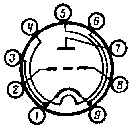 1- cathode;
1- cathode;
2-
grid;
3-
cathode;
4-
filament;
5-
filament;
6-
cathode;
7-
anode;
8-
grid;
9-
cathode
Characteristics:
Plate voltage
... 150 volts
Cathode
resistor for self-bias
.
30 ohm
General
characteristics:
Minimum
Nominal
Maximum
Slew
rate, mA/V
34
45
56
Amplification
factor
36
52
68
Input
impedance at F=60 MHz, kOhm
-
3.5
-
Vibro-noise, mV (rms)* - - 100
Life
time guaranteed, hours
3000
-
-
Direct
Interelectrode Capacitances:
Input,
pF
9.5
11.5
13.5
Output,
pF
1.8
1.9
2.2
Heater-cathode,
pF
-
6.8
9.5
Heater-grid
-
-
0.13
Center design
points:
Minimum heater
voltage
..
6.0 volts
Maximum plate
voltage
150 volts
Maximum
cathode-heater voltage **
100 volts
Maximum
cathode current
52 mA
Maximum plate
dissipation
... 7.8 watts
Maximum grid
resistance
.. 150 kOhm
Bulb
temperature (common environment)
210 C
Bulb
temperature ( T air =85 C)
230
C
Notes:
* - measured with plate resistor = 0.5 kOhm
**- potential of heater is negative relative to
cathode
Mechanical data:
Single
beats with acceleration
.Up to
500g
Multiple
beats with acceleration
. Up to 75g
Temperature
range
.. 60C
..+85C
Humidity
(with T= 40C)
.. Up to 98 %
| Plate characteristics: | Transfer
(Grid -Plate) Characteristics: |
|
|
|
Uc
Grid Voltage, V
Ia
Plate Current, mA

Pspice Model
.subckt 6C45-PE
1 2 3 ; plate grid cathode
+ params: mu=47.4501 ex=2.374193 kg1=268.615545 kp=485.735371
kvb=501.503636 rgi=300
+ ccg=2.4p cgp=4p ccp=.7p
e1 7 0 value= {v(1,3)/kp*log(1+exp(kp*(1/mu+v(2,3)/sqrt(kvb+v(1,3)*v(1,3)))))}
re1 7 0 1g
g1 1 3 value= {(pwr(v(7),ex)+pwrs(v(7),ex))/kg1}
rcp 1 3 1g
c1 2 3 {ccg}
c2 1 2 {cgp}
c3 1 3 {ccp}
r1 2 5 {rgi}
d3 5 3 dx
.model dx d(is=1n rs=1 cjo=10pf tt=1n)
.ends

VG=[0,
-0.5, -1, -1.5, -2, -2.5, -3, -3.5, -4, -4.5]
The 6H30
This
double triode, although designed for high-current pulse mode operation, can be
seen as an improved version of the E182CC-SQ vacuum tube and
therefore perfect as Line Preamplifier and driver for power tubes. The official
presentation appeared as an advertisement on Glass
Audio
pages from Balanced
Audio Technologies.
Target applications include:
·
High End Audio, Line Preamplifiers (SRPPs, Mu-Followers Balanced Stages), HeadPhone
Amps, Class AB2 Low Power OTL's, Impedance Matching.
·
Pro Audio: Low Impedance,Low gain OTL balanced lines. High current cathode
followers.
6H30

Double
triode for work in pulse modes in various radio gears.
Shape-
miniature glass bulb.
Mass-20
gramms. Size h=72.5, d=22.5
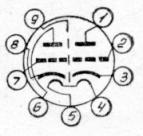 1- plate 1;
1- plate 1;
2-
grid 1;
3-
cathode 1;
4-
heater;
5-
heater;
6-
plate 2;
7- grid2;
8-
cathode 2;
9-
shield;
General
characteristics:
(with
Heater Voltage=6.3 V; Plate Voltage=80 V; Self-bias resistor =56 Ohm)
1.Heater
current
825(+75-100) mA
2.Plate
current for each triode
...40(+10-10) mA
3.Pulse
plate current for each triode
..2-3 A
4.Plate
current with Ug= -12V
.< 30uA
5.Reverse
grid current
..< 1uA
6.Slew
rate
18(+5-5) mA/V
7.Amplification
factor for each triode
..15(+3-3)
8.Vibro-noise
voltage with Rp=0.5 kOhm
25-50 mV
9.Direct
interelectrode capacitancies:
Input(Cgc)
6.3(+0.9-0.9) pF
Output(Ccp)
.2.4(+0.5-0.5) pF
Transfer(Cgp)
...6.0-7.1 pF
Between anodes
<0.2pF
10.Lifetime
..>10000
hrs
11.Term
of workability-pulse plate current
>1.7 A
Center design
points:
1.Heater
voltage
.6.0-6.6 V
2.Maximum
plate voltage..
250V
3.Maximum
plate voltage for closed tube
.1050V
4.Maximum
grid voltage in pulse mode t<=100uS
-50V
5.Maximum
heater-cathode voltage
..400V
6.Maximum
pulse current for each triode
.6A
7.Maximum cathode current for each triode
.100 mA
8.Maximum
plate dissipation for each triode
4 Watts
9.Maximum
grid dissipation for each triode
.0.4 Watts
10.Maximum
grid resistance
.300 kOhm
11.Maximum
bulb temperature
.250 degrees C
Mechanical data:
1.Continuous
vibration 5-2000 Hz with acceleration..20g
2.Multiple
beats with acceleration
.150g
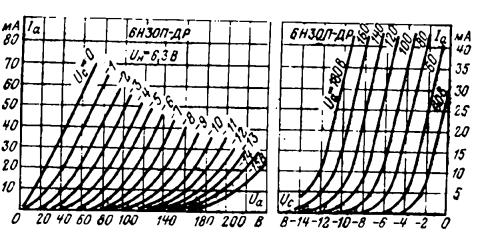

SUBCKT KTRIODE A G
K
+ PARAMS: MU=37.58299
EX=1.132166 KG1=428.9745 KP=402.1368 KVB=321.0256
+ LG=0.2U VBIG=-0.2
EG=1.0389 KG=0.000769 KRG=3.685584 KVG=0.090943
+ CCG=2.4P CGP=3.9P
CCP=0.7P CCH=5.6P
E1 7 0 VALUE =
{V(A,K) / KP * LOG(1 + EXP(KP * (1/MU + V(G,K) / SQRT(KVB + V(A,K) * V(A,K)))))}
RE1 7 0 1G
G1 A K VALUE = {(PWR(V(7), EX) + PWRS(V(7), EX)) / KG1}
RCP A K 1G ;
C1 G K {CCG} ;
C2 G A {CGP} ;
C3 A K {CCP} ;
C4 K 0 {CCH} ;
E10 10 0 VALUE = {IF(V(A) - V(K) > 0, V(A) - V(K),
0)}
E11 11 0 VALUE = {IF(V(G) - V(K) > VBIG, V(G) - V(K)
- VBIG, 0)}
E12 12 0 VALUE = {(KG * (V(11) ** EG) *
+ (((KRG - 1) / (KVG * V(10) + 1)) + 1)) + LG}
G2 G K VALUE = {IF(V(12) > LG, V(12), LG)}
.ENDS
*******************
.SUBCKT 6N30P-DR A G K
X1 A G K KTRIODE
+ PARAMS: MU=14.82339 EX=1.386938 KG1=255.6717 KP=99.30537
KVB=1042.421
+ LG=0.2U VBIG=-0.1 EG=1.414474 KG=0.000769 KRG=5 KVG=0.027177
+ CCG=6.3P CGP=6.5P CCP=2.4P CCH=8P
.ENDS

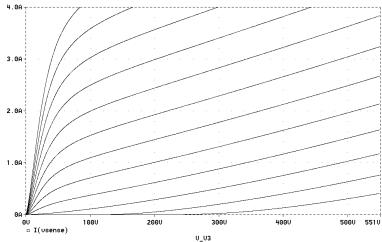
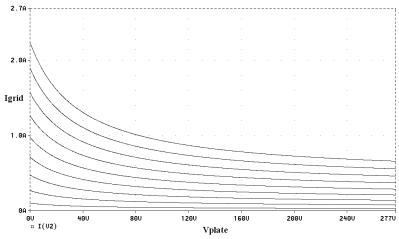
|
|
By Joseph Luk |
More Technical Details Here.....
The 6C46
This
subminiature tube born as a low power series regulator is a sort of 6C33 bonsai.
The more interesting characteristic is the low voltage/high current
mode of operation. This excellent feature permits easy building of
high-performance truly low-voltage line preamplifier. Further the interesting
plate dissipation (Pd=4.5W) allows the experimentation for low
voltage low power amplifiers.
6C46
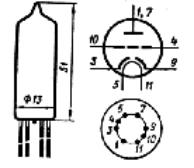
High
reliability super-miniature glass triode with 1 anode and 2 sepatate grids and
cathodes. Designed to use in electronic voltage regulators. Lifetime >=500
hrs.
Mass
< 7grams.
Heater
voltage
..6.3 (+0.7-0.6)V
Heater
current
500 (+50-50) mA
Plate
voltage
..42V
Grid
voltage
..-1V
Slew
rate
...20 (+10-5) mA/V
Amplification
factor
......7 (+2-2)
Plate
current
..60 (+15-15) mA
Reverse
grid current
..<0.4 uA
Maximum
plate voltage
....250V
Maximum
plate voltage for closed tube
330V
Minimum grid voltage
..-75V
Maximum
cathode current
.100 mA
Maximum
plate dissipation
4.5 Watts
Maximum
heater-cathode voltage
.150 V
Maximum
grid resistance
..0.25 MOhm
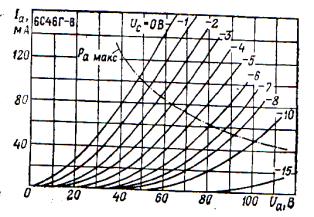
Pspice Model
.subckt
vt6c46pe 1 2 3 ; placca griglia catodo
+
params: mu=8.955 ex=1.5966 kg1=282.77 kp=31.47 kvb=796.640
+
rgi=2k ccg=6p cgp=7.5p ccp=1.76p
e1
7 0 value=
+{v(1,3)/kp*log(1+exp(kp*(1/mu+v(2,3)/sqrt(kvb+v(1,3)*v(1,3)))))}
re1
7 0 1g
g1
1 3 value= {(pwr(v(7),ex)+pwrs(v(7),ex))/kg1}
rcp
1 3 1g
c1
2 3 {ccg}
c2
1 2 {cgp}
c3
1 3 {ccp}
r1 2 5 {rgi}
d3 5 3 dx
.model dx d(is=1n rs=1 cjo=10pf tt=1n)
.ends
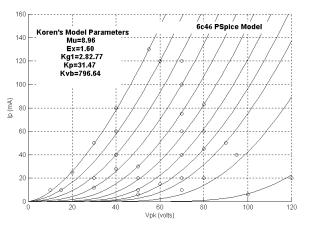
Conclusions
The
triodes triade 6C45, 6C46, 6H30 is worth to cover
alls the low power audio needs and in the 3rd part this article Ill
present a few of practical examples. For the buying you can refer to the Russian
distributor STC
Navigator [2].
References:
[1] http://www.paeng-design.com
[3]
The Russian Vacuum
Tubes Technical Repository
Acknowledgment:
I
would like to thank Pavel Skidan who helped me in the search of
technical documentations and in the translactions from Russian to English.
|
What did you
think of this article? |